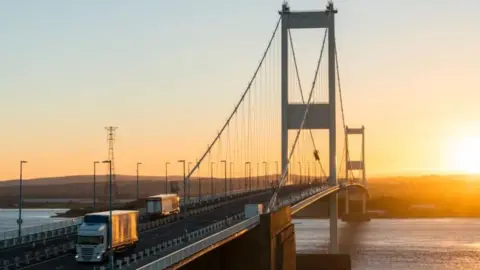Closing bridge to HGVs 'devastating' for hauliers
 Getty Images
Getty ImagesHauliers say that a decision to ban heavy goods vehicles from the M48 Severn Bridge could be "devastating" for their businesses.
The ban will come into force for at least 18 months from 27 May after National Highways discovered the cables supporting the structure are deteriorating.
A director of an Avonmouth-based haulage company warned the alternative route into Wales via the M4 Prince of Wales Bridge is not always reliable, and drivers could be forced to take lengthy detours around Gloucester.
National Highways said it has "no choice" but to impose weight limits in the interest of public safety, and that it was looking for a long-term solution to allow HGVs to return "in a controlled manner".
It is currently proposing a "technological solution" that will manage the flow of HGVs over the bridge to prevent overloading it.
Jamie Burton, director of M&J Transport, told BBC Radio Bristol the impact of the Prince of Wales Bridge shutting due to a a crash or poor weather "would be devastating" once HGVs can no longer use the Severn crossing.
"They've not put any plans or any thought into what's going to happen when it gets busy in the summer, or if there's any closures. The cost to the industry and the cost to us personally would be immense," he said.
Caroline Tovey of Richard Tovey Transport pointed out that even when the Prince of Wales Bridge is open, it still adds a 14-mile detour onto journeys.
She added some areas may find "large vehicles being rerouted through their communities".
"It isn't just about the money, it's about infrastructure that isn't used to (HGVs)."
Claire Young, Liberal Democrat MP for Thornbury and Yate, said it could cost between £300m and £600m to augment the bridge so it can continue carrying its current load.
 British Pathe
British Pathe"All this infrastructure was put in at the same time in the 60s, it's now ageing, we are seeing problems," she said.
"It has the potential to really impact the local economy. The government says its top priority is growth. If we are going to have that, we need the infrastructure to support it."
Chris Pope, from National Highways, said the agency had no choice but to temporarily ban HGVs from the bridge.
"We want to keep the bridge running for people but the solution that we have found is that we've managed to keep it open for 90% of people," he said.
"It is safe, it's all about loading and unfortunately we are in a position where about 85% of the loading that the main suspension cables are carrying is actually the bridge itself."
Mr Pope added that National Highways was looking for a solution that will allow HGVs to return "in a controlled manner so we don't overload the bridge".
Follow BBC Bristol on Facebook, X and Instagram. Send your story ideas to us on email or via WhatsApp on 0800 313 4630.
